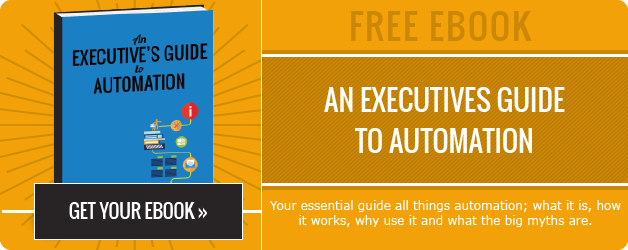Business Process Automation is everywhere and has fast become the ace in a CTO’s pocket. But it’s been around for longer than you think… Much longer. Just think about how ancient water sellers transformed their product delivery; After walking buckets back and forth (a manual solution), someone posited that there must be a more efficient delivery mechanism, and conceptualised the aqueduct (an automated solution). The same is true of today’s operational processes.
Manual solutions, or for the sake of our example, ‘bucket’ solutions, are fraught with problems and dependant on too many variables to be reliable:
- Buckets might break or be different sizes
- People would fill the buckets to different levels;
- Walk at different speeds;
- Or need time off
- Water might even be spilled along the way
Whilst aqueducts allowed water sellers to automate water delivery by diverting streams into man-made distribution channels, modern day automation channels tasks to their destinations via pre-programmed computer processes, negating the need for manual intervention. This means that once a process has begun, step-by-step tasks happen automatically and without human involvement.
But what is business automation? Why do businesses consider it? And how can you get started? All are good questions. Continue reading as we take you through everything you need to know about business process automation.
| Everything you Need to Know About Business Process Automation: | ||
| 1 What is Business Process Automation? 2. Why Should you Automate? 3. When to Automate 4. How to Get Started 5. Automation FAQs 6. Small Business 7. A Supportive Company Culture is Key 8. Tips for Automation Success 9. In Conclusion |
What is Business Process Automation?
Business process automation is all about transforming tedious and repetitive manual tasks into streamlined, computer-operated processes. According to Wikipedia, it “consists of integrating applications, restructuring labor resources and using software applications throughout the organization."
In reality, it is about:
- Analysing the processes that exist within your organisation (small or enterprise)
- Identifying the ones that slow you down to the extent that they cost more than they are worth (these tend to be manually driven)
- Understanding if there is a better, more efficient way to execute that process by automating it
- Putting that plan into action
More specifically: It is “Using a set of preprogrammed workflows to convert a manual task with consistent and repeatable steps into one which a computer completes for you.”
The best processes for an ISP to automate are the ones that cost you the most money, time and efficiency to complete manually. Good examples include Billing, Collections, Provisioning and Customer Support. As more businesses are leveraging automation to find efficiencies in these areas, and as technology continues to expand, new opportunities to automate are being uncovered. Think Drones (for online purchase delivery) and Mobile Apps (for off-site technician and stock management). Some ISPs are even using automated operations to offer their customers products and services via an ecommerce online portal.
Why Should You Automate?
It’s a tough job running a successful business, be it small, enterprise or otherwise. Balancing your sales pipeline with effective operational delivery, the morale and effectiveness of your staff with recruitment and all the other technical details such as tax and compliance is tough. Not to mention a personal work-life balance.
I hear your cynical sniggering from way over here.
Short Answer - “Efficiency Gains”
There are a number of benefits of business process automation but business efficiency is usually one of the key reasons to automate your business.
Efficiency is the core of business. In order to build and maintain your competitive advantage you need to succeed at retaining revenue, reducing complexity, responding to your customers needs quickly and dominating customer service. All the while balancing costs and making consistently well-educated business decisions. ‘Efficiency’ is the best way to describe doing all of the above in the best way, or, most efficient way possible.
Automation directly affects efficiency and supports all of these goals, and it is for this reason that businesses start to think about automation. If you’re still not sure and need some more information about the benefits of automation, here are “7 things I wish I'd learnt earlier”.
When to Automate
“But when is the right time?” I hear you ask through gritted teeth, especially as automation is most certainly an investment. Businesses tend to automate (if they haven’t done so from the beginning) once processes cost more to complete than the revenue they contribute towards.
That ‘cost’ is usually a factor of:
- Reducing levels of customer service (and resulting high customer churn)
- Slow time to market (when your competitors are getting there faster)
- Increasing revenue leakage
- Higher resource costs that seem to be getting out of control
- Losses of strategic/competitive advantage
- Reduced cross-department communications that result in inefficient processes
This is typically when businesses start to think about how they can work smarter.
How to get Started
Transforming your business operations is an investment, where the success of the project is directly proportional to the success of your business. So absolutely, this is not something you should embark upon lightly. It is a project that requires a good understanding of your existing processes and particular pain points, a strong objective and a well-matched software partner.
Remember, automation doesn't always have to be an all-singing, all-dancing fancy pants installation that does everything short of bringing you coffee. It can be as simple as setting up email filters and using canned responses, as suggested by The Mogul Mom.
Our recommendation is this: Draw up a list of the key problems you’re experiencing. Break it up into 'absolutely essential to fix' and 'nice to have'. Be tough, be honest and be thorough.
Having a clear understanding of what you want to achieve through automation helps you to remain on-goal. If you're unsure, you could end up with a solution that ticks off all your 'nice to haves' but doesn't actually propel your business forward.
If you’re not sure what some of the more jargony terms surrounding automation mean, this article should help.
Automation FAQ’s
Here’s a list of the most common questions we receive from businesses investigating automation:
1. Is Business Automation Software a smart investment?
A smart investment is one where (a) your business as a whole and future prospects are significantly improved as a direct result of the investment, and (b) you receive a favourable financial return on your investment (ROI).
You don’t need to break the bank in order to deliver on your business automation needs. In fact, if implemented properly, your software will show you a ROI sooner rather than later. By offering an end-to-end view of processes and allowing departments to work in close unison by integrating your disparate systems, you will find that your business automation software will help to reduce revenue leakage, speed up your time to market, increase your customer satisfaction, reduce your process complexity and increase your business visibility. Further ROI is seen by IT departments as a result of less complex infrastructure and licensing requirements - all of which helps to justify your spend. So yes, business automation software is a smart investment.
2. How can I get buy-in from my staff for such a fundamental change?
There are many concerns and some pretty stubborn myths surrounding automation, including:
- It's too expensive
- Fear from staff that they’ll lose their job
- It won't do what I want it to
- It'll solve all a business’s problems
- You need a lot of technical understanding
- It's a project too big for my small business
We've addressed some of the biggest myths in this post, but our advice to businesses is always this: It's your business, you are the experts and you need to understand what you want to achieve through automation.
Whilst Change Management is a topic unto itself, our experience is that a combination of clear communication, working closely with each involved department to understand their unique pain-points whilst working together to establish the most effective solution, and solid training makes all the difference when gaining buy-in from staff. And remember, human interaction still matters.
3. Off-the-shelf or customised?
- Off-the-shelf is a solution that already exists as a fully functioning package/platform that you buy into. They typically come with a set of fundamental rules that your business needs to adhere to.
- Customised is a solution that’s built for you, around your business requirements and rules. This takes a bit longer to implement, but is built around your unique operation.
There are pro’s and con’s to both and really the most important factor to keep in mind when making your decision lies with your business objectives. What are you trying to achieve, and, which solution offers you exactly what your business needs?
4. How do I select the right partner?
For any long term investment it’s important to pick the right partner. Someone who understands your needs and has the ability to grow with you. Our eBook ‘6 Questions to Ask Before Choosing your Business Automation Software’ can help you identify which company to partner with.
5. How does SOLID’s business automation software actually work?
SOLID is a Business Automation Software platform, and since 2001 we have been on a mission to ‘automate your admin’. We enable ISPs to sell any service to their customers from anywhere in the world, in record time.
Through a simple and intuitive interface, SOLID automates the full customer lifecycle:
- Sales and opportunity tracking
- Customer relationship management
- Business workflow automation
- Service and network provisioning
- Subscription, ad-hoc and usage billing
- Collections and debtors account management
- Customer support and incident management
- Financials and general ledger
Our platform is designed to increase business visibility and efficiency, and provide your customers with a consistent experience. 100% Scalable and based on an extensible design, SOLID is as flexible as your business needs to be.
This infographic details how a typical order moves through the system from conception to support.
Business Automation isn’t just for Enterprise Organisations, it’s Perfect for Small Business too
A small business is required to do pretty much the same tasks as a larger business, but with fewer people. This presents a few very specific challenges around processes, time slicing, scalability and skill sets.
How can automation benefit a small business: by easing up manual tasks and streamlining processes - essentially saving you something all small businesses need more of - time.
Tools like G Suite, Zapier, IFTTT, Hubspot, SOLID, BambooHR and Zendesk can help you automate everything from your inbox to marketing, tech support, HR and business operations.
Essentially, automation specifically helps small business because:
- Processes become scalable (up and down): So you can very quickly (and at a reduced cost) manage the scale of your operations to suit your business.
- You become more effective, much quicker: SaaS (Software as a Service) is software delivered over the internet, rather than the old school CD installation route. ‘Encarta’ anyone? The point is that with such a massive variety of online software available at the click of button, you’d be crazy not to leverage someone else’s genius to accomplish a task quicker and better.
- There’s a decreasing operating cost: Essentially, the more you do, the cheaper the cost-per-task becomes. Your business benefits exponentially for the same initial investment. We’ve got more detail over here, but you get the picture.
A Supportive Company Culture is Key
The sooner you embrace automation and include it as part of your company culture, the sooner you’ll reap the benefits, reduce your operating costs and improve scalability.
Culture is the key to success
Company culture is the cornerstone of automation success and, according to Forbes, should be designed to motivate your team to succeed.
The idea is that you set your business up for success by cultivating a company culture that supports innovative thinking, and supports those who promote it. You get the most from automation when the people who drive and leverage it see great results and are able to further leverage those results to truly innovate within the business.
It is important to understand that the success of your business is dependant on everyone within it, rather than just the traditional 'leaders', and by actively engaging in a culture that supports the innovative thinking required to reap the full value of automation - you will achieve automation success.
It is the success of your culture that will define the success of your automation strategy.
Here’s a list of resources for great automation examples and inspiration:
- Five Great Business Automation Resources To Follow
- Research other people’s successes to see if you have any challenges in common
- Check out these inspiring videos that give 10 Awesome Examples of Automation
- Our Featured Projects list show what a few of our customers have done after they’ve implemented our automation platform
Tips for Automation Success
Our blog post titled “The Best Tips for Automation Success” goes through these in more detail, but in a nutshell, our experience is that businesses who do the following tend to succeed more than those who don’t:
- Trust the company you choose to be your automation partner
- Analyse your current processes (Pre-Automation)
- Define exactly what you want to achieve
- Have a laser-like focus
- Incentivise
- Embrace Agile Project methodology
- Benchmark yourself.
In Conclusion,
The best processes for an ISP to automate are the ones that cost you the most money, time and efficiency to complete manually.
It’s very easy to get caught up in the daily tasks of running a business, and those who are overwhelmed by the seemingly uphill challenge ahead of them to streamline their operations tend to live by the adage "if it ain't broke, don't fix it".
But consider the story of the cooking frog: if you put a frog in a pot of cold water and slowly turn the heat up, he will cook before he notices the change. Whereas, if you already have the water boiling and then pop him in, he’s likely to jump straight out.
Bad, inefficient processes can only operate for so long until they achieve a critical mass where they start affecting:
- Customer service
- Time to market
- Revenue leakage
- Resource costs
- Strategic/competitive advantage
- Cross-department communications
Automation is powerful technology that allows you to revolutionise previously manual and time-consuming tasks. It enables efficiency, aids productivity, saves time and reduces costs (amongst other benefits). Automation can be anything from auto-applying filters in your gmail inbox to automating your entire billing and collections functions.
It is technology, harnessed to extract maximum value from your operational processes.
But remember, with great power, comes great responsibility.








Comment